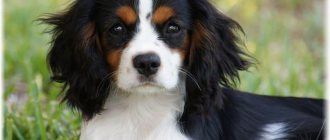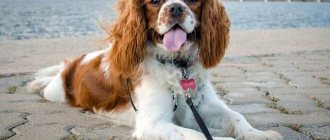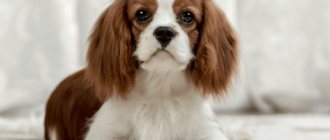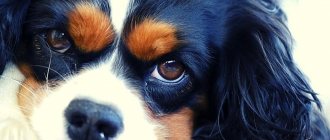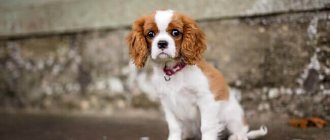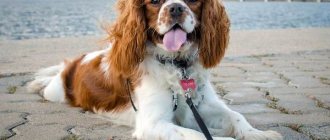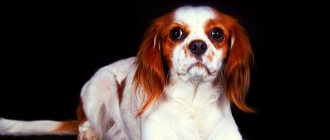The world first learned about such a breed of dog as the Cavalier King Charles Spaniel in the 13th century; it was then that the first mentions of funny four-legged friends were found, sounding in the lyrics of German and Austrian songs. As hunting dogs, they quickly gained popularity. But their cute appearance and friendliness quickly transferred true hunters from forests and fields to the homes of people from high society, after which the royal dogs became permanent residences of the palaces.
History of the origin of the breed
The exact country of origin of the breed is unknown. It is believed that in the 9th century the first representatives of the breed were brought by the Celts to Britain and were sincerely loved by the English nobility. The small dogs were excellent affectionate companions and could be used for hunting. True, their qualities as a hunter began to be used less and less, and representatives of the breed firmly occupied the boudoir of ladies and gentlemen.
The heyday of the breed in England came in the 13th century, when it was maintained at the highest level. With the accession of King Charles II to the throne, spaniels began to enjoy unlimited privileges and received the prefixes “king” and “Charles”. Under him, mini spaniels even had access to the British Parliament building.
However, with the accession of William II of Orange to the throne, interest in the breed began to fade, since this ruler was an adherent of another breed of dog - pugs. They flooded all the streets and houses of London, as well as the palace itself. Breeders of that time, to please the monarch, began crossing King Charles with pugs, and the dog practically lost its original appearance.
Only at the beginning of the 20th century in Europe there was a desire to revive the breed in its original form. The British Kennel Club has offered a reward for those breeders who achieve the closest resemblance to the breed standard. Already in 1928, the first representatives appeared who were as close as possible in appearance to their ancestors.
Since that time, the breed received a new name - Cavalier King Charles Spaniel.
Photo: wikimedia.org
Buying a Cavalier King Charles Spaniel Puppy Questions and Answers. 1. What's the best reason to get yourself a boyfriend? For children? No, no and NO! These little restless creatures are not able to take care of a puppy, and even more so, they cannot take responsibility for a living creature, which they consider their toy. The dog should first of all be wanted by the person who will primarily care for it, and of course, all other family members should not be against it. 2. I have a child. Is this dog good with children? Yes, gentlemen are very good with children. It is best if the child is over 5 years old when you get the puppy. These dogs love balls, chase, hide and seek - in general, any children's games. They can run and play endlessly - as much as the child wants. And its cheerful and affectionate character will make this dog the best friend for your child. The gentleman will never bite or even growl at a child - no matter what they do to him. Rather, you need to make sure that the child does not accidentally hurt the little gentleman. 3. Do they shed? Yes, these dogs shed. But their hair is very easy to remove with a broom or vacuum cleaner (unlike short-haired breeds). By the way, gentlemen do not smell like dogs, unlike most dogs. 4. Is it difficult to care for their fur? No. No complex care is needed. Just brush it about once a week. Their silky coat hardly tangles and does not require any special care. It is sometimes necessary to comb the long ears, which easily become tangled. These dogs are not cut or trimmed at all. 5. Will this dog get along with my cat? Yes. The Cavalier will easily get along with any family member who walks on two or four legs. Including with a cat. But the cat may not like it very much if you bring a dog into the house. 6. Do you need to walk a lot? Is it possible to litter train this dog? The Cavalier is not such a small dog to go to the litter box. I don’t know, maybe there is someone who taught their boyfriend to do this. But think about it: it is bad for the dog’s health if it is deprived of walks. Dogs love walks and look forward to them! Don't deprive them of this pleasure!!! And in the sense of “getting things done quickly” when it’s cold or raining, that’s what they themselves are quite aware of. 7. I want to get a dog for the first time; I didn’t have any dogs before. Will I have any difficulties with my upbringing? The Cavalier King Charles Spaniel is an ideal dog for those who have never owned a dog before. He is easy to train and quickly understands what they want from him. And strives to please the owners. And his gentle character will not cause you any parenting problems. 8. How is their health? The Cavalier King Charles Spaniel is generally a very healthy and strong dog. If you take a puppy from a responsible breeder, then you will not have any health problems. Their average lifespan, like most breeds, is 12-15 years. 9. What is a responsible breeder? Responsible breeders have their own breeding program and work towards improving the quality of their dogs, without the main goal of making as much money as possible from selling puppies. They closely monitor the health of their breeding dogs, treat them as necessary, carry out preventative measures, and do not allow animals that are sick or have bad genetics to be bred. They spend a lot of time selecting pairs, studying their pedigrees, and generally getting as much information as possible about the puppies' future parents. They check the puppy's health and give all necessary vaccinations before sending it to its new home. They do not sell puppies before they are ready to live independently - after the 8th week. They carefully review all puppy requests to select the most suitable owners. And after selling the puppy, they maintain contact with the puppy's new owners to make sure everything is okay with it and to answer any questions the new owners may have. They also take good care of their old dogs, even though they are no longer used for breeding, and also require much more time and money to maintain them. This is only a small, but most necessary part of the definition of a “responsible breeder”. 10. Who is better to choose - a boy or a girl? If you are not involved in breeding, then it’s all the same. Both sexes have a very soft and flexible character. Perhaps boys are even more affectionate than girls. The reproductive instinct of this breed is not very strong, it will not cause you any inconvenience, no matter who you choose. 11. Are gentlemen girls more affectionate than boys? In gentlemen there is no particular difference between the sexes in temperament and the degree of attachment to the owner or mistress. There are much more individual differences between different dogs. If there is a difference in relationships, it is more in the type of relationship than in the strength of feeling. They usually say about gentlemen: the girl loves you, and the boy is in love with you. Therefore, do not limit yourself to any one gender, unless you have a goal to choose a puppy of a specific gender. 12. What problems might we have if we get a Cavalier - unlike other breeds? No special problems. Perhaps a very strong attachment to the owners. Sometimes the hunting instinct can cause some inconvenience. 13. Where can I buy a Cavalier King Charles Spaniel puppy? They are expensive? Unfortunately, in Russia this breed is still very rare; there are literally only a few breeders. But in Europe and America these dogs are very popular, there are quite a lot of kennels there. The price range is quite wide (depending on the kennel and the class of the puppy). A pet-class puppy costs less, but not by much: about 25%. Only a specific breeder will answer the exact price question. 14.Does a puppy need a crate? A crate can help teach your puppy to be clean. In addition, it can be used to ensure the safety of the puppy when he is forced to be left alone for a while. It can also be used to transport the puppy in the car. But this is quite cruel: leaving a dog in a cage for a long time without the opportunity to run, exercise and communicate with the owner. In addition, sitting in a crate for a long time will have a bad effect on the development of the puppy’s limbs. 15. If my dog has worms, does that mean people can become infected? No, it's not that simple: worms have a rather complex reproduction cycle. It is very difficult to get infected directly from a dog. Dogs become infected with worms if they have fleas. Simply put, she needs to swallow a flea with larvae inside to become infected with worms. There are also other types of worms that can be contracted by eating poorly cooked fish or meat. Therefore, the best prevention is to treat your dog for fleas and follow the rules of preparing food for both yourself and the dogs. 16. What type of people and what is this breed suitable for? For several centuries, gentlemen were the best companions. Every royal person of Great Britain and Denmark had a gentleman in childhood, and often later, when they were already on the throne. They are also called “comforters” for their ability to relieve stress by perching on your lap or perching next to you on a chair. In principle, this breed is suitable for any person, but not an aggressive one. 17. Is it true that gentlemen and their owners are considered snobs? Some articles mentioned this breed and the owners of the Cavaliers, among whom there are many royalty, aristocrats, presidents, businessmen, owners of large companies and movie stars. In addition, some well-known breeders puzzle potential puppy owners with their biased and intense “questioning” about their lives. 18. What makes a good puppy owner? This is a person who carefully studied the issue and chose the appropriate breed. And then he fed him correctly with high-quality food, took the puppy to the veterinarian on time, for all the necessary vaccinations, and devoted sufficient time to playing and raising the puppy. In addition, adequate care must be taken to ensure his health and safety. And this is a personal responsibility for a small loving creature that lasts until death do you part
Description of the breed
The main characteristics of spaniels that are “created by a king”:
- the weight of the dog is determined by gender, females are noticeably lighter than males, and is 5-6 kg for girls and 8-10 for boys;
- The height of dogs also depends on gender, the difference is about 10 cm. The size of an adult dog: females grow up to 25 cm, males up to 35 cm at the withers;
- color . With the establishment of a new breed standard, color options took root: four types in total. The first is black combined with beautiful bright tan marks; the second is ruby, so named because in the sunlight this bright red color sparkles like a precious stone; the third is called “tricolor” because it combines black, red, and piebald colors; and, finally, the fourth type - Blenheim - bright red spots with clear outlines stand out on a white-pearl base;
- head _ The muzzle is wedge-shaped, the lips do not droop;
- bite ;
- eyes are round, protruding and shiny;
- ears with elongated hair;
- the body is small but muscular, with a flat back and prominent ribs;
- the tail is in constant motion and is proportional to the body. Sometimes it can be docked by one third of the total length;
- the coat is thick, shiny and very silky;
- life expectancy is from 10 to 15 years.
Photo: wikimedia.org
The difference between a Cavalier and King Charles
Let us note that these two breeds are very closely related historically and, until a certain point in their development, were considered one. In modern conditions, these are two different breeds that differ in a number of ways:
- Nose length. The cavaliers have longer ones, the kings have snub noses;
- Skull shape. For a cavalier it is almost flat, for a king it looks like a dome;
- Bite. The Cavalier has a scissor bite, the King has an undershot bite;
- Size difference. Kings are smaller than Cavaliers.
Photo: sidewaysdogs.com
Difference between Cavalier King Charles and King Charles Spaniel
It is worth noting that King Charles Spaniels and Cavalier King Charles Spaniels have common historical roots, and until recently they were considered dogs of the same color. But modern standards distinguish them into two different subspecies, which differ from each other in the following indicators:
- Cavaliers have a longer nose than King Charleses. In the latter type they are more snub-nosed.
- Cavaliers have a flat skull, while Kings have a dome-shaped skull.
- The former have a scissor bite, the latter have an overshot bite.
- Cavaliers are much larger than King Charles.
Cavalier King Charles Spaniels are loyal friends. They will brighten up the lives of older people and bring joy and laughter to families with children. But it is worth remembering that dogs require full dedication and attention in return.
Character and behavioral characteristics
The most striking feature of the mini spaniel's character is his involvement in the family. He is everywhere and everywhere. Such a dog needs communication; if left alone at home, it literally suffers and can act out.
Gentlemen often suffer from excessive timidity and can “withdraw into themselves” if the owner allows himself to be rude. However, they love everyone around them and are not suitable for the role of a security guard. They allow themselves to bark a lot and loudly, especially from an excess of feelings.
Photo: pixabay.com
Education and training
These dogs have very developed intelligence, so they quickly understand and learn commands. However, after a certain time, the spaniel may stop following the owner's commands due to boring activities.
Dog handlers advise training to be carried out in the form of active play, constantly introducing variety and acting exclusively with affection.
Since the dog has quite developed hunting instincts, during a walk a representative of the royal breed can find an object to pursue. Therefore, you need to teach the dog basic commands - “come”, “fu”.
It is necessary to raise an animal from the first days of its appearance in the house, because often such pets take part in exhibitions. From the age of five months, it is necessary to accustom the puppy to the show stand. Initially, the position is reinforced with encouragement, and as soon as the baby understands the essence, he is taught the command “stand!”
Experienced handlers advise dividing the training of the command “stand!” and “sit!” by time. First, the dog must master the command that fixes him in the stance, otherwise at a crucial moment he may confuse the commands.
Learning ability
The cavalier should be taught a standard set of commands. Thanks to his inquisitive mind, he can be trained quickly, especially if the owner uses positive reinforcement.
Spaniels are most receptive to training between the ages of one month and six months. During this period, special attention should be paid to raising the puppy. Establish a set of rules in the house and demand their implementation. Before training, the baby must learn a nickname, then get used to the leash and collar.
The commands are introduced sequentially - training begins in a calm environment with the commands “Sit!” and “Lie down!”, then “To me”, “Near” and others are added. When the skill is consolidated, complications are introduced - endurance and distractions.
The spaniel is sensitive to the intonations in the owner's voice - all commands must be given in an even and clear voice, without shouting. Be sure to joyfully praise after a successful exercise and encourage it with a treat. The worst punishment for this dog is the owner's harsh tone; spanking, even weak, is unacceptable.
Diseases
Cavaliers are not distinguished by good health; we can identify the main diseases that are inherent in the breed and occur quite often:
- heart pathologies;
- Chiari syndrome;
- inflammatory diseases of the paraanal glands;
- allergic reactions;
- prolapse;
- joint dislocation;
- arthritis;
- hernias;
- episodic falling syndrome.
At the first signs of allergic reactions in a puppy, it is recommended to choose hypoallergenic food.
Peculiarities of the breed include the frequent occurrence of false pregnancy in bitches. In addition, if pathologies are identified in an animal, it is not recommended to breed, at least until the health problems are resolved.
Photo: pixabay.com
Buying a puppy
To buy a Cavalier puppy, find breed clubs and breeders in your city. Find litters ready for sale and study the pedigrees of the parents. Ask the breeder questions about typical diseases of the breed and possible difficulties. Answer his questions about the future conditions of keeping the puppy.
Examine the litter and choose the puppy with the best conformation and personality traits. A promising puppy must have:
- well developed nostrils;
- sloping forehead;
- large eyes, widely spaced;
- scissor bite;
- arched neck;
- normal muscle tone;
- the behavior of a “gentleman” is a calm attitude towards others, adequate communication with fellow humans.
Care
The undoubted advantages of the breed include the gentlemen’s particular unpretentiousness and the absence of any special care requirements.
Despite all the general cheerfulness and activity at home, a spaniel of this species does not like long stays on the street, especially walks in the rain. It will be enough to take your pet out twice a day for a short period of time, which will allow the dog to do all the work.
Your pet's ears will require special attention. They need to be checked regularly, since they are hanging and close to the head, poorly ventilated and prone to inflammation.
Bathing will depend on the class of the puppy. You need to wash your show puppy once a week, using a whole arsenal of professional products. A simple pet can be bathed once a month using coat conditioner for easy combing. Note that a healthy animal practically does not smell like a dog.
Dogs under one year of age often develop eye problems. They "flow", especially on Blenheims. If such a problem occurs, the area around the eyes must be treated with a special lotion.
A haircut
Cavalier wool is hypoallergenic and does not cause any negative reactions in humans. This is an undoubted advantage of the breed, because allergy sufferers can safely get such a dog.
But the dog's fur is very thick and falls out even outside the molting period. To avoid hair from appearing throughout the house, you need to comb it out daily or go to a salon for grooming. After this procedure, the dog will look like it’s at a show and the house will be clean.
In addition to all hygiene procedures, the dog needs periodic destruction of parasites and vaccinations.
Photo: wikimedia.org
Health and illness
The Cavalier King Charles Spaniel breed initially had good immunity. But due to the fact that the classic breed was practically lost for some time and was revived thanks to selection, spaniels developed diseases of the genetic breed. There are also predispositions to organ defects.
Cavalier Spaniels are susceptible to diseases of the mucous membranes of the eyes and ears. These diseases appear due to the structural features of the skull and muzzle. If you do not take care of the organs, dirt gets into the ear canals, and an inflammatory process with elements of decay begins.
Cavaliers are prone to severe tearing. Therefore, the eyes must be constantly rubbed with warm water and special solutions.
Spaniels are prone to the following diseases:
- Obesity.
- Diabetes.
- Allergy.
- Hernias. Moreover, they can be congenital and acquired. The only way to get rid of the problem is through surgery or special massage.
- Dislocations of the joints of the elbows and knees.
- Damage to intervertebral discs. To prevent the disease, stress on the hind legs should be avoided.
- Hereditary diseases include constant teeth chattering. This disease is called flycatching.
- Another hereditary problem is Legg-Calvé-Perthes disease. This is an inflammatory disease of the femoral heads. Drug treatment will help reduce pain.
- Arthrosis of the joints.
- Heart problems, including heart failure.
- Breathing problems.
The health of an animal depends on many factors. One of them is timely vaccination against infectious diseases. To avoid infection, your puppy should be vaccinated from 2 months of age. The first vaccinations are given in the nursery.
There, a veterinary passport and pedigree are created for each puppy. Next, all subsequent vaccinations are included in the document:
- At 2, 3 months, six months and a year, vaccinations are carried out against enteritis, parainfluenza, leptospirosis, salmonella, distemper, and hepatitis. In the future, vaccinations are repeated annually.
- At 7 months a rabies injection is given. It also requires repetition once a year. Without this vaccination, it is not possible to export the animal outside the country.
To protect your puppy and not expose him to possible illness, you should follow several rules:
- from birth until the second vaccination you should not take the puppy for a walk;
- Before vaccination, the animal should be disinfected against worms. This must be done no later than 2 weeks before the injection.
- Nursing females and males should not be vaccinated after mating;
- Dogs must be vaccinated in specialized veterinary clinics. The specialist must put the name of the vaccination, drug and date of vaccination in the passport.
- after the injection, the dog is quarantined for 2 weeks;
- If side effects occur, you should consult a doctor.
Most diseases of cavaliers do not pose a danger to the animal if the problem is identified in a timely manner and treatment is started.
Lifespan
On average, dogs of this breed live 10-15 years . It is important to know that how long pets live depends on their content. With good and proper care they can live several years longer.
Feeding
Dog handlers advise choosing dry food as a diet for representatives of this breed. The main condition is that the food be exclusively premium class.
This does not mean that he cannot be fed natural food. The basis of the diet should include:
- meat raw or cooked. It is better to serve beef raw, having cleaned it of veins;
- offal. It is better to give boiled and finely chopped;
- cereals The best option would be rice and buckwheat;
- flax seeds. It is recommended to add to food in order to improve the condition of the coat;
- eggs and dairy products. The norm is two eggs a week, always boiled until hard, 200 grams of cottage cheese and a little kefir.
It's better not to give bones. For these dogs they will do more harm than good, especially for long bones.
Photo: maxpixel.net
Maintenance, care and nutrition
Cavalier King Charles have long hair, but despite this they do not require special care. They do not need regular haircuts or trimming. No special combing or washing is required. Regular brushing during shedding and washing once a week is sufficient. For the procedure, it is recommended to use special shampoos for dogs.
Cavaliers are pets and should only be kept at home. For your pet, you need to purchase bowls for water and food, a bed, toys and hygiene products. He should also have his own place to rest and sleep.
Nutrition
Spaniels are not picky when it comes to food. But laziness can lead to obesity.
The diet and number of doses per day depends on the age of the dog:
- Until one and a half to two months, the puppy’s nutrition depends on the mother. Natural instincts play a role here, which owners should not suppress by placing the puppy with the mother only for feeding.
- Complementary feeding begins at 6 weeks. Additional food is given to puppies 4 times a day.
- From six months the dog is fed 3 times a day, from a year - 2 times. Some experts recommend feeding an adult once a day.
Both natural products and dry food are suitable for feeding spaniels. The advantages of the second option are ease of use and the ability to clearly control portions. In addition, there is a large selection of food for dogs with different temperaments and coat lengths. Preference should be given to premium food and grain-free varieties.
If natural feeding is chosen to feed your pet, you should develop a diet and strictly adhere to it. You cannot change the products included in the portion.
For spaniels, half of the total diet should be meat: beef, poultry, boneless lamb. It can be either boiled or raw.
Be sure to include in the menu:
- porridge made from rice, buckwheat, oatmeal;
- vegetables and fruits. It is forbidden to feed dogs potatoes, melons, pears and citrus fruits.
- sea fish. It must be boiled and the bones removed.
- boiled eggs;
- low-fat cottage cheese;
- kefir.
In addition to some vegetables, you should not give your spaniel:
- pork;
- butter;
- sweet and flour;
- Exotic fruits;
- fried foods with a spicy taste;
- Fat is prohibited.
An important rule is the separation of food. This means that you cannot mix natural and dry feeding. This will have a bad effect on the spaniel's digestive system and well-being.
Content
During walks, you should carefully ensure that the dog does not pick up leftover food and other objects from the ground. They can cause digestive system upset. In most cases, such leftovers contain various viruses and bacteria that cause dangerous diseases.
Your pet should always have fresh, clean water. He also needs vitamins from puppyhood. You should consult your veterinarian about what to give your dog.
An important stage in the care and maintenance of an animal is the treatment of ears and eyes. Clean your ears and wash your eyes daily. The pet’s teeth are brushed twice a week, and nails are cut once every 2 months.
Every summer and fall, your dog should be treated for fleas and ticks. Harmful insects accumulate in the ear area. Due to the fact that in this breed they are elongated, the likelihood of picking up parasites increases.
Price and where to buy a puppy
Since the end of the last century, interest in representatives of the breed has increased in Russia. Naturally, purchasing a purebred puppy is only possible in a well-known nursery that values its reputation. In addition, breeders always stay in touch with the new owner of the puppy and will always come to the rescue and advise on issues of maintenance, illness and training.
If you try to save money and look for a representative of the gentlemen in the newspaper or on the Internet, you can buy a mixed breed or even just a similar representative of the mongrel. No one guarantees the health of the pet in this case.
The cost of puppies is quite high and varies from 70 to 100 thousand rubles. Such an expensive price is due to the fact that for this money you will receive a breed or show-class puppy with all the accompanying documents. For this price, your pet will have titled parents and the prospect of a successful exhibition career. In addition, the breeder will do tests for the presence of major pathologies.
Photo: wikimedia.org
Rules for choosing puppies
Expert opinion
Anna Abramenko
An avid dog lover. Experience in veterinary medicine since 2009.
Ask a Question
In order not to make a mistake and purchase a purebred dog, turn to reputable kennels. They will offer a baby at least three months old who has already completed all the necessary vaccinations.
Such puppies adapt more easily to new conditions. Documents confirming compliance with the standard and describing the pedigree must be attached.
During a visual examination, attention is paid to the absence of aggression or excessive cowardice. Check the condition of the ears and eyes, which should be clean. By tactile palpation of the tummy, the absence of bloating is determined, which may indicate problems with digestion.
Choosing a nickname
Oddly enough, but choosing a worthy nickname for a girl or boy of this breed is quite difficult. On the one hand, the dog is cheerful, spontaneous and active, which dictates the choice of a simple and affectionate name. On the other hand, being "royalty" requires a name that sounds like a title.
Names with Japanese or Chinese sounds have become popular among the owners of these dogs.
For girls : Akana, Rowena, Akina, Yukki, Shinuka.
For boys : Locky, Rockwell, Tuxie, Amethyst, Rocky, Lando.
Photo: wikimedia.org
Advantages and disadvantages
Based on the experience of Cavalier owners, one can highlight the pros and cons inherent in the breed, which will help the future owner decide on the desire to purchase just such a pet.
pros
- incredibly dedicated and faithful;
- do not need constant long walks, although if they are accustomed to them they will only be happy;
- the wool is hypoallergenic and does not smell like dog;
- They love children, but are also great for older people;
- get along well with any pets.
Minuses
- they themselves are severe allergy sufferers and have a large list of breed pathologies;
- are often too annoying;
- can afford to bite;
- great owners can “appropriate” any economic item and it will not be possible to take it away.
Photo: pexels.com

